Tútsı Elá
This is a unilingual Dene story that talks about how to make a canoe. It begins:
Ɂı̨hbé anagoderade. Tútsı sı̨́ı̨ eláhyaa t’á k’énat’ó begha nezǫ. Hı̨dú ɂıhbé eláhyaa bets’ę gha.
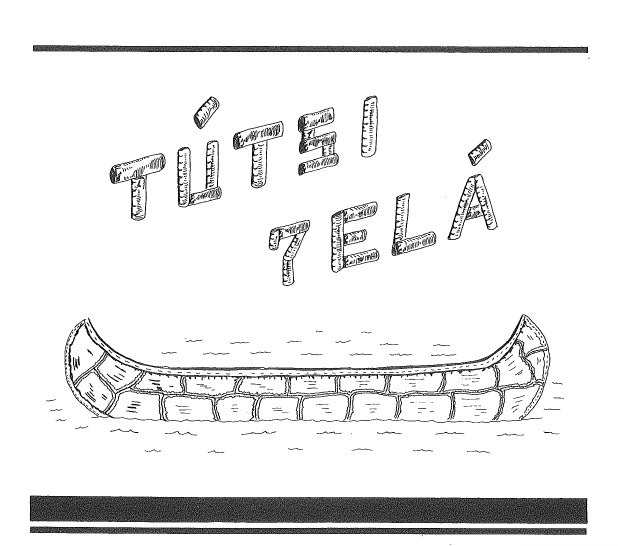
Access this Resource:
Available from the Ɂehdzo Got’ı̨nę Gots’ę́ Nákedı archives. Contact This email address is being protected from spambots. You need JavaScript enabled to view it. for access and see the Release and User Agreement form on the database home page.
Tetso, John, Elsie Vital and Gina Bayha. Tútsı Elá. Edited by Jane Modeste and Fibbie Tatti. Yellowknife: Government of the Northwest Territories Department of Education, n.d.
Tútsı Ɂá
This is a unilingual Dene story that talks about how to make snowshoes. It begins:
Sahcho nǫhblálewá yu weda. Nǫhbále yu Tu1tsı gha ɂah hehtsı̨ ghálaeda.
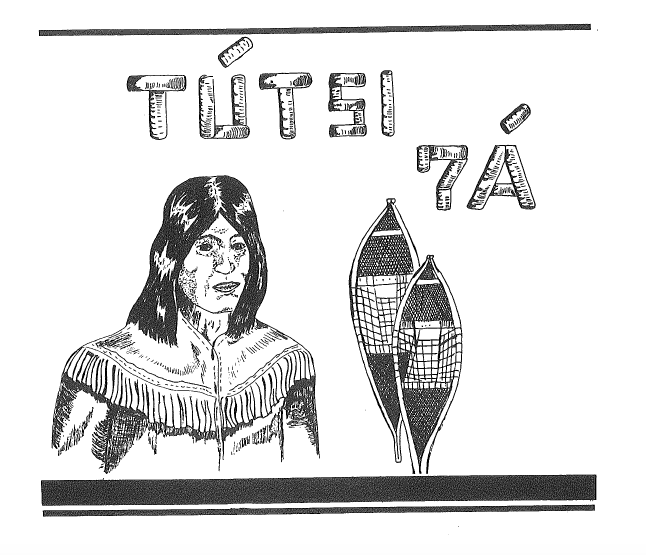
Access this Resource:
Available from the Ɂehdzo Got’ı̨nę Gots’ę́ Nákedı archives. Contact This email address is being protected from spambots. You need JavaScript enabled to view it. for access and see the Release and User Agreement form on the database home page.
Tetso, John, Elsie Vital, Gina Bayha, Jane Modeste and Fibbie Tatti [eds.]. Tútsı Ɂá. Yellowknife: Department of Education of the Northwest Territories, n.d.
Denı́hch’éa Bedzıho Wáı̨zha
This is a unilingual story with hand-drawn illustrations (by Shelia Hodgkinson) and Dene Kedǝ text. It has no English guide, and it comes with Dene words paired with illustrations at the end of the story (for example, edé and a picture of antlers).
The first section reads:
Yahnı̨́ı̨ ts’ę́ hı̨kwé Nerégháe, gokw’ı k’e ekúhdé, dene ke ekwę́ ka k’ǫ́ǫgı́dé gohé są́ denı́ch’éa łée k’énada redı. Nágeze gha get’ı̨ ǫt’s t’a denı́hch’éa sı̨́ı dene shǫ náze réhtła redı.
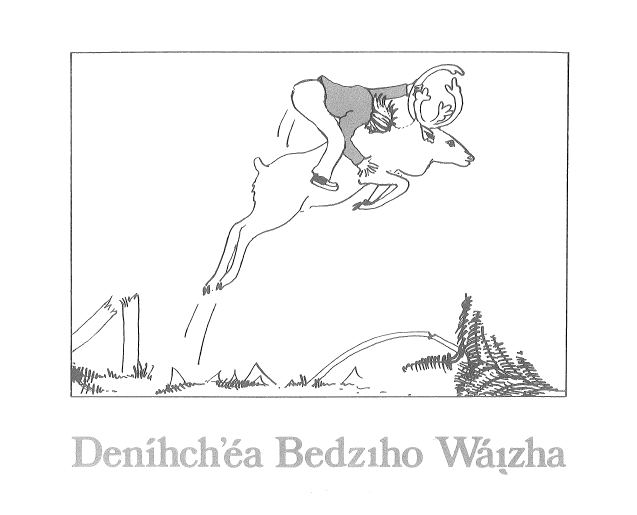
Access this Resource:
Available from the Ɂehdzo Got’ı̨nę Gots’ę́ Nákedı by permission of the Délı̨nę Got'ı̨nę Government. Contact This email address is being protected from spambots. You need JavaScript enabled to view it. for access and see the Release and User Agreement form on the database home page.
Taneton, Louie, Jane Modeste, Fibbie Tatti, Sheila Hodgkinson [Illustrations]. Denı́hch’éa Bedzıho Wáı̨zha. Northwest Territories Department of Education and Fort Franklin Band Council, 1983.
Tatsǫ́ Ekwę́ Nánéhɂı̨
This is a unilingual story with hand-drawn illustrations and Dene text about a journey to find Caribou, with help from a Raven, an Owl, and a Wolf. The caribou are all walled into an enclosure, but the wolf helps the Dene break them free. This document has a stamp on the last page that reads “Interpreter/Translator Program.” The first two lines read:
Yahnı̨́ı̨ ts’ę́ łǫ́ǫ́ łánı nágedé. Bé wı́le dúwé redı Dene ke dzene táoneht’é nágezé kúlú asıł łágıhwhı́le.
Dene ke gohé bé wı́le dúwé kúlú nágedé ékagı̨t’e haı̨lé, “Tatsǫ́ xáhtáętła,” goréjá t’a, dene ke areyǫné yets’ę́ káłeréhzha.
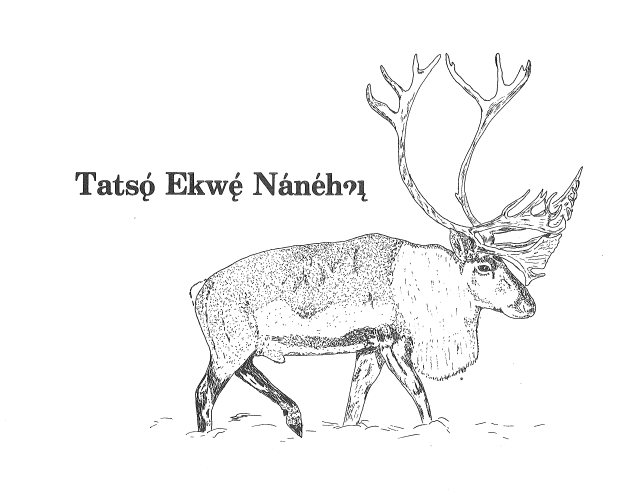
Access this Resource:
Available from the Ɂehdzo Got’ı̨nę Gots’ę́ Nákedı by permission of the Délı̨nę Got'ı̨nę Government. Contact This email address is being protected from spambots. You need JavaScript enabled to view it. for access and see the Release and User Agreement form on the database home page.
Modeste, Joe, and Johnny Neyelle. Tatsǫ́ Ekwę́ Nánéhɂı̨, edited by Fibbie Tattie and Jane Modeste. Copyright Fort Franklin Band Council. n.d.
Chıleku Náke Įk’ǫ́ T’á Echoho Łágenı’hdé.
This is a unilingual story with hand-drawn illustrations and Dene text. It also has an Englısh guide at the end of the document (p. 35) but it comes with clear instructions that the teacher is to use the document’s Dene language only when teaching. The story is also paired with a Dene questionnaire about the story for students. It is about two men who grow past marrying age: their community tells them to go look for wives, so they do so, and save a different community from monsters that have been eating people. They use Dene medicine to kill the monsters, and end up marrying and settling down in the new, saved community.
The first section reads:
Yahnı̨́ı̨ ts’ę́ chıleku náke, ts’ǫ́dane gı̨lı̨ gots’ę ts’éku gı́hchú le, ékagı̨t’é déot’ı̨nę hé dene gı̨lı̨ redı. Kút’a surı ɂǫhdaa ts’ę́ nǫwá le agejá ekáa gonǫ ékagóhdı. “Seyaa ékahht’e gha dúwé, ası̨́ dúle ts’éku hat’ı̨ ghǫ ɂaht’e,” góhdı. “Hęɂę,” gedı redı, “ékanı̨́ nı̨dé ts’éku hút’ı̨́ gha k’énaút’á kúlú,” gedı redı.
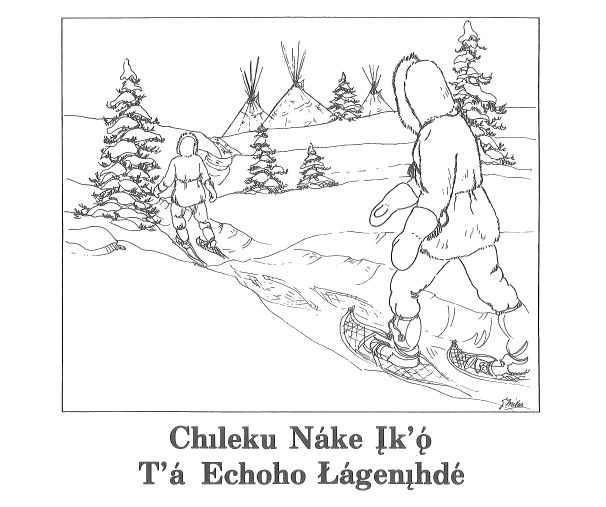
Access this Resource:
Available from the Ɂehdzo Got’ı̨nę Gots’ę́ Nákedı by permission of the Délı̨nę Got'ı̨nę Government. Contact This email address is being protected from spambots. You need JavaScript enabled to view it. for access and see the Release and User Agreement form on the database home page.
Modeste, Isodore, Jane Modeste and Fibbie Tatti. Chıleku Náke Įk’ǫ́ T’á Echoho Łágenı’hdé. Northwest Territories Department of Education and the Fort Franklin Band Council, n.d.
Echoho Náke Gok’énı̨ge Gónı̨á
This is a unilingual story with hand-drawn illustrations (by Sheila Hodgkinson) and Dene Kedǝ text. It is about a journey. The first section reads:
Yahnı̨́ı̨ ts’ę́ nę k’ále bek’ǫ́ne ekúu
Etı́ratǫ ekúhdé kwe náke ełets’ę́
Nı́danıhɂa, ets’énárakwé hé
Edúhnárakwé hé héredı sı̨́ı gok’énı̨ge ts’eretła le redı. Xaıdó yı́ı kúlú dene ke gohé tę táreɂé t’á dene łǫ tut s’ę́ hı́hłé redı
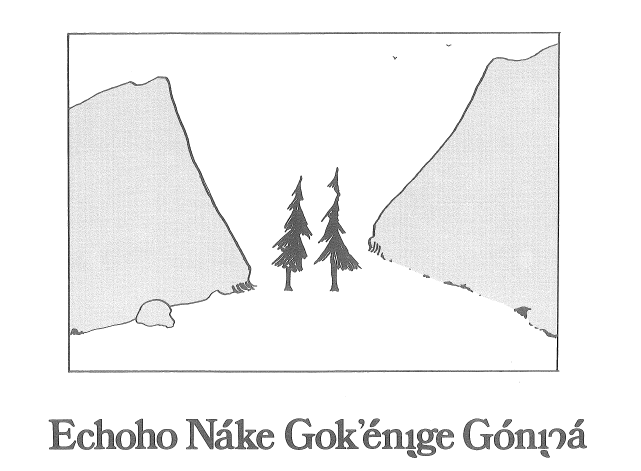
Access this Resource:
Available from the Ɂehdzo Got’ı̨nę Gots’ę́ Nákedı by permission of the Délı̨nę Got'ı̨nę Government. Contact This email address is being protected from spambots. You need JavaScript enabled to view it. for access and see the Release and User Agreement form on the database home page.
Modeste, Isidore, Jane Modeste, and Fibbie Tatti. Echoho Náke Gok’énı̨ge Gónı̨á. Northwest Territories Department of Education and Fort Franklin Band Council, n.d.
Nę K'ǝ Dene Ts'ı̨lı̨ Forum Terms of Reference
This document is a policy statement revising the terms of reference of the Sahtú Environmental Research and Monitoring Forum.
From text:
Many land-based projects and programs are underway in the Sahtú Region, with the involvement of various community, regional, territorial and federal departments as well as industry and academic partners. During a three-day interagency meeting in November, 2013, a consensus was reached that research and monitoring programs and projects should be well coordinated, with strong guidance from Sahtú communities. Governments and industry require research that will support wise, evidence-based decision-making.
As a consequence, Sahtú organizations and the Government of the Northwest Territories (led by the Department of Environment and Natural Resources) agreed to convene a group known as the “Sahtú Environmental Research and Monitoring Forum”. In 2017 a Dene name was adopted to reflect an expanded mandate for the Forum - Nę K’ǝ Dene Ts’ı̨lı̨ - meaning “living on the land.”
Access this Resource:
Click the link below.
Annual Report on Official Languages 2015-2016
Every fiscal year, the Government of the Northwest Territories issues a record of measures taken to implement the Official Languages Act. Each report details developments in both French and Aboriginal language programming. Many programs focus on connecting youth with elders, training teachers, developing curriculum, and providing government services in as many languages as possible.
Some events from this reporting period:
- Describes language plan and notes that ECE is currently working on an updated version for 2015-2020.
- The North Slavey member of the Official Languages Board was Theresa Etchinelle, with Jane Modeste as alternate. For the Aboriginal Language Revitalization Board, it was Dora Grandjambe with Anne Kochon-Orlias as alternate.
- The boards are currently developing a process for amalgamation, which will require amendments to the Official Languages Act.
- The report summarizes the TRC Calls to Action specific to language and culture. It identifies points that it is already undertaking and commits to calling on the federal government for Aboriginal language revitalization funding.
- It then presents one page summaries of each language region’s five year plan, with updates and highlights of 2015-16.
Access this Resource:
The Government of the Northwest Territories makes reports from the last decade available here: https://www.ece.gov.nt.ca/en/services/francophone-affairs-secretariat/official-languages-annual-reports
Government of the Northwest Territories. Annual Report on Official Languages. Yellowknife: 2016.
Ets’ulah: “The language is like ets’ulah"
Ets’ulah is Dene Love Song, a neglected musical form that Laura Tutcho argues can be used to revitalize the Sahtúgotı̨nę language. Ets’ulah is “one of the oldest traditions for representing kinship links, family legacies, and ties to the land and life on the land.” (6) Laura Tutcho begins by presenting an overview of Dene history, and the importance of Dene language to knowing “who we are as people” (9) today. The history of the residential schools and the different attitudes of traders, missionaries, and teachers towards Dene language and culture are also presented. Next, the author talks about the current status of language teaching in Délı̨nę, making some key points:
- She recommends a bilingual upbringing that teaches children the language and also encourages graduation.
- She talks about a “cultural inclusion program” (12) that teaches children to drum, sing Slavey songs, sew, and survive on the land.
- She identifies a dire need for more Sahtú Dene teachers and recommends that the Délı̨nę Self Government priorities include a “strong position about how our children and people should be taught.” (13)
- She comments that Canadian laws, mǫ́la ɂeɂá, “can never do justice to our way of knowing.” (17)
The author talks about her own story, moving from the land to a formidable English day school at the age of 8 and needing to speak English to avoid the strap. She talks about the lessons she learned in her community and some of the traditions she remembers about hunting, taboos, and other teachings. One central question she addresses is how to engage youth in learning the same knowledge, particularly their Dene language. She sees ets’ulah as one way to get youth interested in Dene Kedǝ and Dene Ts’ı̨lı̨.
From Abstract: "My project is about how ets’ulah (Dene love song) can contribute to the revitalization of Sahtúgot’ı̨nę language. The Sahtúgot’ı̨nę language is spoken in the community of Délı̨ ne, Northwest Territories. My research highlights the Sahtúgot'ine tradition of ets'ulah, a musical form that will entice young people to use their language. Ets'ulah is the most neglected of the musical expressions of culture, yet one of the oldest traditions for representing kinship links, family legacies, and ties to the land and life on the land. I provide a study of noted singer the late Eliza Blondin to help revitalize Sahtúgot’ı̨ nę language through the value of ets'ulah, for as Besha Blondin, Eliza’s daughter, says, “the language is like ets’ulah”."
Read other University of Victoria Language Revitalization MA Theses from Susan Saunders and Fibbie Tatti.
Access this Resource:
This thesis has been made available open access by the University of Victoria: https://www.uvic.ca/education/indigenous/assets/docs/Tutcho_Laura_MEd_2016.pdf
Read more Masters in Indigenous Languages Revitalization Theses and Projects from UVic here: https://www.uvic.ca/education/indigenous/research/graduate/index.php
Tutcho, Laura. Ets’ulah: “The language is like ets’ulah.” Master’s Thesis, University of Victoria, 2016.
Chikashshanompa'Ilanompohóli Bíyyi'ka'chi [we will always speak the Chickasaw language]: Considering the vitality and efficacy of Chickasaw language reclamation.
This dissertation engages with the stories of different types of Chickasaw language activists. Some young adult professionals have created careers centered around language revitalization; Chickasaw citizens who reside outside of the Nation also participate in language revitalization, and finally, many high school and university students study their language in school. The author works with all of these perspectives to talk about three themes helping Chickasaw language revitalization: “1) a raised critical Chickasaw consciousness, 2) the conception of Chickashshanompa’ as cultural practice, and 3) the (re)valuing of language learners” (11, from abstract).
Access this Resource:
This dissertation has been made available open access from the University of Arizona: https://pqdtopen.proquest.com/doc/1848289974.html?FMT=ABS
Chew, Kari A. B. Chikashshanompa'Ilanompohóli Bíyyi'ka'chi [we will always speak the Chickasaw language]: Considering the vitality and efficacy of Chickasaw language reclamation. Doctoral Thesis, University of Arizona, 2016.


 Phone: 867-374-4040
Phone: 867-374-4040 Email:
Email: